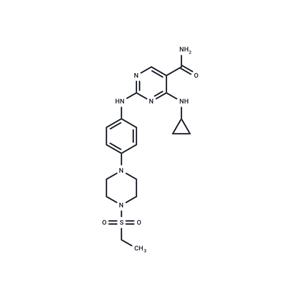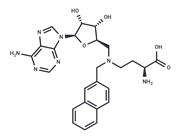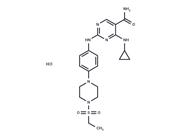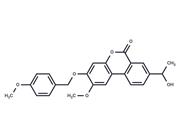| Name | Cerdulatinib |
| Description | Cerdulatinib (PRT2070) is an novel oral dual Syk/JAK inhibitor. |
| Cell Research | Cerdulatinib is dissolved in DMSO. TMD8 cells are transfected with constructs of WT BTK or BTKC481S mutants using kit V, Program U-13 on Amaxa Nucleofector. After transfection, the cells are co-cultured with NKTert cells in a 24-well plate for 24 hrs for recovery. Ibrutinib, cerdulatinib and vehicle (DMSO) are then added into the transfected TMD8 cells and cellular viability is determined with MuseTM Count & Viability kit using Muse Cell Analyzer. The cell survival is determined by flow cytometry using the Annexin V/7-AAD Apoptosis Detection Kit I on freshly isolated CLL cells. |
| In vitro | Cerdulatinib effectively inhibits 60 CLL cells with IC50 values ranging between 0.37 to 10.02 μM, induces apoptosis via MCL-1 down-regulation and PARP cleavage, and overcomes microenvironmental support to trigger CLL cell death at 2 μM. It inhibits both ibrutinib-sensitive and -resistant primary CLL cell proliferation at concentrations of 250-500 nM, targets BTKC481S-transfected cell lines, halts BCR and JAK-STAT signaling, and blocks SYK and JAK leading to the downstream inhibition of AKT, ERK, and the NF-kB pathway. PRT062070, with an IC50 of 0.11 μM, limits stimulated B cell activation marker CD69 expression, demonstrating varied effectiveness against JAK/STAT pathways and induces apoptosis in BCR-signaling competent NHL cell lines at 1 or 3 μM. Cerdulatinib shows inhibitory actions on both ABC and GCB DLBCL cell subtypes, induces caspase 3 and PARP cleavage-mediated apoptosis, inhibits cell cycle progression through RB phosphorylation reduction and cyclin E down-regulation, and blocks JAK/STAT and BCR signaling. It elicits cell death in DLBCL cells under BCR stimulation and in primary human DLBCL samples, disrupts BCR-induced signaling, especially potent from 0.3 to 1 μM in IGHV-unmutated, high BCR signaling, sIgM, CD49d+, or ZAP70+ expressing samples, and neutralizes anti-IgM, IL4/CD40L, or NLC-mediated protection by preventing MCL-1 and BCL-XL upregulation, without affecting BCL-2 expression. Cerdulatinib also synergizes with venetoclax to enhance apoptosis in IL4/CD40L treated samples. |
| In vivo | Cerdulatinib (0.5 mg/kg) causes a nonstatistically significant trend toward reduced ankle inflammation, whereas significant reductions in inflammation are achieved with the 1.5, 3, and 5 mg/kg doses. Besides, Cerdulatinib also affects anticollagen antibody formation. Cerdulatinib (15 mg/kg) suppresses upregulation of splenic B-cell surface CD80/86 and CD69, and inhibits BCR signaling and activation in the spleen after oral dosing in mice[2]. |
| Storage | Powder: -20°C for 3 years | In solvent: -80°C for 1 year | Shipping with blue ice. |
| Solubility Information | DMSO : 40 mg/mL (89.78 mM), Sonication is recommended.
|
| Keywords | Syk | Spleen tyrosine kinase | inhibit | JAK | PRT 2070 | PRT 062070 | Inhibitor | Cerdulatinib | Janus kinase | PRT-062070 | PRT-2070 |
| Inhibitors Related | ANTHRAQUINONE-2-CARBOXYLIC ACID | Ruxolitinib phosphate | Gefitinib |
| Related Compound Libraries | Bioactive Compound Library | Tyrosine Kinase Inhibitor Library | Anti-Cancer Clinical Compound Library | Drug Repurposing Compound Library | Inhibitor Library | Anti-Aging Compound Library | Bioactive Compounds Library Max | Anti-Cancer Active Compound Library | Anti-Cancer Drug Library |

 United States
United States



